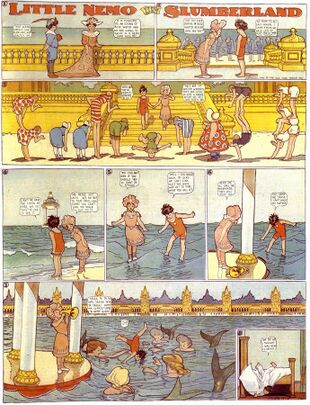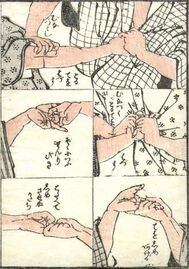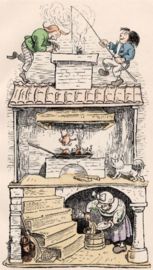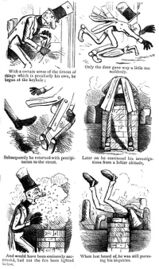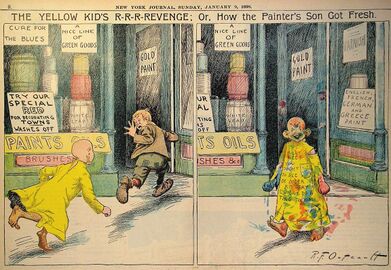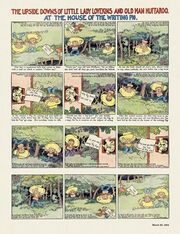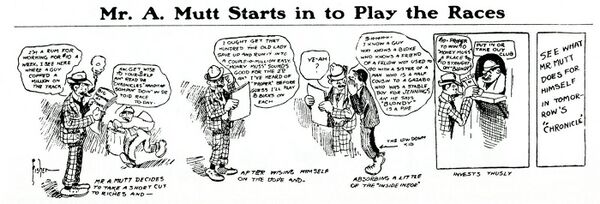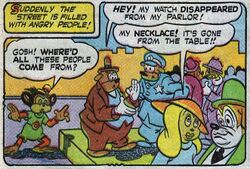Social:Comics
}}
a medium used to express ideas with images, often combined with text or other visual information. It typically takes the form Panel (comics)|panels]] of images. Textual devices such as speech balloons, captions, and onomatopoeia can indicate dialogue, narration, sound effects, or other information. There is no consensus among theorists and historians on a definition of comics; some emphasize the combination of images and text, some sequentiality or other image relations, and others historical aspects such as mass reproduction or the use of recurring characters. Cartooning and other forms of illustration are the most common image-making means in comics; Photo comics is a form that uses photographic images. Common forms include comic strips, editorial and gag cartoons, and comic books. Since the late 20th century, bound volumes such as graphic novels, comic albums, and tankōbon have become increasingly common, along with webcomics as well as scientific/medical comics.[1]
The history of comics has followed different paths in different cultures. Scholars have posited a pre-history as far back as the Lascaux cave paintings. By the mid-20th century, comics flourished, particularly in the United States, western Europe (especially France and Belgium), and Japan. The history of European comics is often traced to Rodolphe Töpffer's cartoon strips of the 1830s, while Wilhelm Busch and his Max and Moritz also had a global impact from 1865 on,[2][3][4][5] and became popular following the success in the 1930s of strips and books such as The Adventures of Tintin. American comics emerged as a mass medium in the early 20th century with the advent of newspaper comic strips; magazine-style comic books followed in the 1930s, in which the superhero genre became prominent after Superman appeared in 1938. Histories of Japanese comics and cartooning (manga) propose origins as early as the 12th century, Japanese comics are generally held separate from the evolution of Euro-American comics and Western comic art probably originated in 17th Italy,[6] modern Japanese comic strips emerged in the early 20th century, and the output of comics magazines and books rapidly expanded in the post-World War II era (1945–) with the popularity of cartoonists such as Osamu Tezuka. Comics has had a lowbrow reputation for much of their history, but towards the end of the 20th century began to find greater acceptance with the public and academics.
The English term comics is used as a singular noun when it refers to the medium itself (e.g. "Comics is a visual art form."), but becomes plural when referring to works collectively (e.g. "Comics are popular reading material.").
Origins and traditions
- Examples of early comics
The European, American, and Japanese comics traditions have followed different paths.[7] Europeans have seen their tradition as beginning with the Swiss Rodolphe Töpffer from as early as 1827 and Americans have seen the origin of theirs in Richard F. Outcault's 1890s newspaper strip The Yellow Kid, though many Americans have come to recognize Töpffer's precedence. Wilhelm Busch directly influenced Rudolph Dirks and his Katzenjammer Kids.[8][9][10][11]({{{1}}}, {{{2}}}) Japan has a long history of satirical cartoons and comics leading up to the World War II era. The ukiyo-e artist Hokusai popularized the Japanese term for comics and cartooning, manga, in the early 19th century.({{{1}}}, {{{2}}}) In the 1930s Harry "A" Chesler started a comics studio, which eventually at its height employed 40 artists working for 50 different publishers who helped make the comics medium flourish in "the Golden Age of Comics" after World War II.[12] In the post-war era modern Japanese comics began to flourish when Osamu Tezuka produced a prolific body of work.({{{1}}}, {{{2}}}) Towards the close of the 20th century, these three traditions converged in a trend towards book-length comics: the comic album in Europe, the tankōbon[lower-alpha 1] in Japan, and the graphic novel in the English-speaking countries.[7]
Outside of these genealogies, comics theorists and historians have seen precedents for comics in the Lascaux cave paintings({{{1}}}, {{{2}}}) in France (some of which appear to be chronological sequences of images), Egyptian hieroglyphs, Trajan's Column in Rome,[13] the 11th-century Norman Bayeux Tapestry,({{{1}}}, {{{2}}}) the 1370 bois Protat woodcut, the 15th-century Ars moriendi and block books, Michelangelo's The Last Judgment in the Sistine Chapel,[13] and William Hogarth's 18th-century sequential engravings,[14] amongst others.[13][lower-alpha 2]
English-language comics
Illustrated humour periodicals were popular in 19th-century Britain, the earliest of which was the short-lived The Glasgow Looking Glass in 1825.[16] The most popular was Punch,[17] which popularized the term cartoon for its humorous caricatures.[18] On occasion the cartoons in these magazines appeared in sequences;[17] the character Ally Sloper featured in the earliest serialized comic strip when the character began to feature in its own weekly magazine in 1884.[19]
American comics developed out of such magazines as Puck, Judge, and Life. The success of illustrated humour supplements in the New York World and later the New York American, particularly Outcault's The Yellow Kid, led to the development of newspaper comic strips. Early Sunday strips were full-page[20] and often in colour. Between 1896 and 1901 cartoonists experimented with sequentiality, movement, and speech balloons.[21] An example is Gustave Verbeek, who wrote his comic series "The UpsideDowns of Old Man Muffaroo and Little Lady Lovekins" between 1903 and 1905. These comics were made in such a way that one could read the 6-panel comic, flip the book and keep reading. He made 64 such comics in total. In 2012 a remake of a selection of the comics was made by Marcus Ivarsson in the book 'In Uppåner med Lilla Lisen & Gamle Muppen'. (ISBN:978-91-7089-524-1)
Shorter, black-and-white daily strips began to appear early in the 20th century, and became established in newspapers after the success in 1907 of Bud Fisher's Mutt and Jeff.[22] In Britain, the Amalgamated Press established a popular style of a sequence of images with text beneath them, including Illustrated Chips and Comic Cuts.[23] Humour strips predominated at first, and in the 1920s and 1930s strips with continuing stories in genres such as adventure and drama also became popular.[22]
Thin periodicals called comic books appeared in the 1930s, at first reprinting newspaper comic strips; by the end of the decade, original content began to dominate.[24] The success in 1938 of Action Comics and its lead hero Superman marked the beginning of the Golden Age of Comic Books, in which the superhero genre was prominent.[25] In the UK and the Commonwealth, the DC Thomson-created Dandy (1937) and Beano (1938) became successful humor-based titles, with a combined circulation of over 2 million copies by the 1950s. Their characters, including "Dennis the Menace", "Desperate Dan" and "The Bash Street Kids" have been read by generations of British children.[26] The comics originally experimented with superheroes and action stories before settling on humorous strips featuring a mix of the Amalgamated Press and US comic book styles.[27]
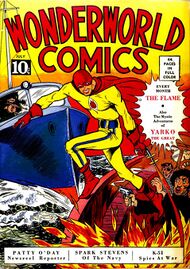
The popularity of superhero comic books declined in the years following World War II,[28] while comic book sales continued to increase as other genres proliferated, such as romance, westerns, crime, horror, and humour.[29] Following a sales peak in the early 1950s, the content of comic books (particularly crime and horror) was subjected to scrutiny from parent groups and government agencies, which culminated in Senate hearings that led to the establishment of the Comics Code Authority self-censoring body.[30] The Code has been blamed for stunting the growth of American comics and maintaining its low status in American society for much of the remainder of the century.[31] Superheroes re-established themselves as the most prominent comic book genre by the early 1960s.[32] Underground comix challenged the Code and readers with adult, countercultural content in the late 1960s and early 1970s.[33] The underground gave birth to the alternative comics movement in the 1980s and its mature, often experimental content in non-superhero genres.({{{1}}}, {{{2}}})
Comics in the US has had a lowbrow reputation stemming from its roots in mass culture; cultural elites sometimes saw popular culture as threatening culture and society. In the latter half of the 20th century, popular culture won greater acceptance, and the lines between high and low culture began to blur. Comics nevertheless continued to be stigmatized, as the medium was seen as entertainment for children and illiterates.[34]
The graphic novel—book-length comics—began to gain attention after Will Eisner popularized the term with his book A Contract with God (1978).[35] The term became widely known with the public after the commercial success of Maus, Watchmen, and The Dark Knight Returns in the mid-1980s.({{{1}}}, {{{2}}}) In the 21st century graphic novels became established in mainstream bookstores[36] and libraries[37] and webcomics became common.[38]
Franco-Belgian and European comics
The francophone Swiss Rodolphe Töpffer produced comic strips beginning in 1827,[13] and published theories behind the form.[39] Wilhelm Busch first puplished his Max and Moritz in 1865.[40] Cartoons appeared widely in newspapers and magazines from the 19th century.[41] The success of Zig et Puce in 1925 popularized the use of speech balloons in European comics, after which Franco-Belgian comics began to dominate.({{{1}}}, {{{2}}}) The Adventures of Tintin, with its signature clear line style,({{{1}}}, {{{2}}}) was first serialized in newspaper comics supplements beginning in 1929,[42] and became an icon of Franco-Belgian comics.({{{1}}}, {{{2}}})
Following the success of Le Journal de Mickey (est. 1934),[43] dedicated comics magazines({{{1}}}, {{{2}}}) like Spirou (est. 1938) and Tintin (1946–1993), and full-colour comic albums became the primary outlet for comics in the mid-20th century.[44] As in the US, at the time comics were seen as infantile and a threat to culture and literacy; commentators stated that "none bear up to the slightest serious analysis",[lower-alpha 3] and that comics were "the sabotage of all art and all literature".[46][lower-alpha 4]
In the 1960s, the term bandes dessinées ("drawn strips") came into wide use in French to denote the medium.[47] Cartoonists began creating comics for mature audiences,({{{1}}}, {{{2}}}) and the term "Ninth Art"[lower-alpha 5] was coined, as comics began to attract public and academic attention as an artform.[48] A group including René Goscinny and Albert Uderzo founded the magazine Pilote in 1959 to give artists greater freedom over their work. Goscinny and Uderzo's The Adventures of Asterix appeared in it[49] and went on to become the best-selling French-language comics series.[50] From 1960, the satirical and taboo-breaking Hara-Kiri defied censorship laws in the countercultural spirit that led to the May 1968 events.[51]
Frustration with censorship and editorial interference led to a group of Pilote cartoonists to found the adults-only L'Écho des savanes in 1972. Adult-oriented and experimental comics flourished in the 1970s, such as in the experimental science fiction of Mœbius and others in Métal hurlant, even mainstream publishers took to publishing prestige-format adult comics.[52]
From the 1980s, mainstream sensibilities were reasserted and serialization became less common as the number of comics magazines decreased and many comics began to be published directly as albums.[53] Smaller publishers such as L'Association[54] that published longer works[55] in non-traditional formats[56] by auteur-istic creators also became common. Since the 1990s, mergers resulted in fewer large publishers, while smaller publishers proliferated. Sales overall continued to grow despite the trend towards a shrinking print market.[57]
Japanese comics

Japanese comics and cartooning (manga),[lower-alpha 7] have a history that has been seen as far back as the anthropomorphic characters in the 12th-to-13th-century Chōjū-jinbutsu-giga, 17th-century toba-e and kibyōshi picture books,[61] and woodblock prints such as ukiyo-e which were popular between the 17th and 20th centuries. The kibyōshi contained examples of sequential images, movement lines,[62] and sound effects.[63]
Illustrated magazines for Western expatriates introduced Western-style satirical cartoons to Japan in the late 19th century. New publications in both the Western and Japanese styles became popular, and at the end of the 1890s, American-style newspaper comics supplements began to appear in Japan,[64] as well as some American comic strips.[61] 1900 saw the debut of the Jiji Manga in the Jiji Shinpō newspaper—the first use of the word "manga" in its modern sense,[60] and where, in 1902, Rakuten Kitazawa began the first modern Japanese comic strip.({{{1}}}, {{{2}}}) By the 1930s, comic strips were serialized in large-circulation monthly girls' and boys' magazine and collected into hardback volumes.({{{1}}}, {{{2}}})
The modern era of comics in Japan began after World War II, propelled by the success of the serialized comics of the prolific Osamu Tezuka[65] and the comic strip Sazae-san.({{{1}}}, {{{2}}}) Genres and audiences diversified over the following decades. Stories are usually first serialized in magazines which are often hundreds of pages thick and may contain over a dozen stories;({{{1}}}, {{{2}}}) they are later compiled in tankōbon-format books.[66] At the turn of the 20th and 21st centuries, nearly a quarter of all printed material in Japan was comics.({{{1}}}, {{{2}}}) Translations became extremely popular in foreign markets—in some cases equaling or surpassing the sales of domestic comics.[67]
Forms and formats
Comic strips are generally short, multipanel comics that have, since the early 20th century, most commonly appeared in newspapers. In the US, daily strips have normally occupied a single tier, while Sunday strips have been given multiple tiers. Since the early 20th century, daily newspaper comic strips have typically been printed in black-and-white and Sunday comics have usually been printed in colour and have often occupied a full newspaper page.[68]
Specialized comics periodicals formats vary greatly in different cultures. Comic books, primarily an American format, are thin periodicals({{{1}}}, {{{2}}}) usually published in colour.[69] European and Japanese comics are frequently serialized in magazines—monthly or weekly in Europe,[60] and usually black-and-white and weekly in Japan.({{{1}}}, {{{2}}}) Japanese comics magazine typically run to hundreds of pages.[70]
Book-length comics take different forms in different cultures. European comic albums are most commonly colour volumes printed at A4-size, a larger page size than used in many other cultures.({{{1}}}, {{{2}}})[44] In English-speaking countries, the trade paperback format originating from collected comic books have also been chosen for original material. Otherwise, bound volumes of comics are called graphic novels and are available in various formats. Despite incorporating the term "novel"—a term normally associated with fiction—"graphic novel" also refers to non-fiction and collections of short works.({{{1}}}, {{{2}}}) Japanese comics are collected in volumes called tankōbon following magazine serialization.[71]
Gag and editorial cartoons usually consist of a single panel, often incorporating a caption or speech balloon. Definitions of comics which emphasize sequence usually exclude gag, editorial, and other single-panel cartoons; they can be included in definitions that emphasize the combination of word and image.[72] Gag cartoons first began to proliferate in broadsheets published in Europe in the 18th and 19th centuries, and the term "cartoon"[lower-alpha 8] was first used to describe them in 1843 in the British humour magazine Punch.[18]
Webcomics are comics that are available on the internet, first being published the 1980s. They are able to potentially reach large audiences, and new readers can often access archives of previous installments.[73] Webcomics can make use of an infinite canvas, meaning they are not constrained by the size or dimensions of a printed comics page.({{{1}}}, {{{2}}})
Some consider storyboards[74] and wordless novels to be comics.[75] Film studios, especially in animation, often use sequences of images as guides for film sequences. These storyboards are not intended as an end product and are rarely seen by the public.[74] Wordless novels are books which use sequences of captionless images to deliver a narrative.[76]
Comics studies
R. C. Harvey, 2001[72]
Similar to the problems of defining literature and film,[77] no consensus has been reached on a definition of the comics medium,[78] and attempted definitions and descriptions have fallen prey to numerous exceptions.[79] Theorists such as Töpffer,[80] R.C. Harvey, Will Eisner,[81] David Carrier,[82] Alain Rey,[78] and Lawrence Grove emphasize the combination of text and images,[83] though there are prominent examples of pantomime comics throughout its history.[79] Other critics, such as Thierry Groensteen[83] and Scott McCloud, have emphasized the primacy of sequences of images.[84] Towards the close of the 20th century, different cultures' discoveries of each other's comics traditions, the rediscovery of forgotten early comics forms, and the rise of new forms made defining comics a more complicated task.[85]
European comics studies began with Töpffer's theories of his own work in the 1840s, which emphasized panel transitions and the visual–verbal combination. No further progress was made until the 1970s.[86] Pierre Fresnault-Deruelle then took a semiotics approach to the study of comics, analyzing text–image relations, page-level image relations, and image discontinuities, or what Scott McCloud later dubbed "closure".[87] In 1987, Henri Vanlier introduced the term multicadre, or "multiframe", to refer to the comics page as a semantic unit.[88] By the 1990s, theorists such as Benoît Peeters and Thierry Groensteen turned attention to artists' poïetic creative choices.[87] Thierry Smolderen and Harry Morgan have held relativistic views of the definition of comics, a medium that has taken various, equally valid forms over its history. Morgan sees comics as a subset of "les littératures dessinées" (or "drawn literatures").[85] French theory has come to give special attention to the page, in distinction from American theories such as McCloud's which focus on panel-to-panel transitions.[88] In the mid-2000s, Neil Cohn began analyzing how comics are understood using tools from cognitive science, extending beyond theory by using actual psychological and neuroscience experiments. This work has argued that sequential images and page layouts both use separate rule-bound "grammars" to be understood that extend beyond panel-to-panel transitions and categorical distinctions of types of layouts, and that the brain's comprehension of comics is similar to comprehending other domains, such as language and music.[89]
Historical narratives of manga tend to focus either on its recent, post-WWII history, or on attempts to demonstrate deep roots in the past, such as to the Chōjū-jinbutsu-giga picture scroll of the 12th and 13th centuries, or the early 19th-century Hokusai Manga.[90] The first historical overview of Japanese comics was Seiki Hosokibara's Nihon Manga-Shi[lower-alpha 9] in 1924.({{{1}}}, {{{2}}}) Early post-war Japanese criticism was mostly of a left-wing political nature until the 1986 publication of Tomofusa Kure's Modern Manga: The Complete Picture,[lower-alpha 10] which de-emphasized politics in favour of formal aspects, such as structure and a "grammar" of comics. The field of manga studies increased rapidly, with numerous books on the subject appearing in the 1990s.[91] Formal theories of manga have focused on developing a "manga expression theory",[lower-alpha 11] with emphasis on spatial relationships in the structure of images on the page, distinguishing the medium from film or literature, in which the flow of time is the basic organizing element.[92] Comics studies courses have proliferated at Japanese universities, and Japan Society for Studies in Cartoon and Comics (ja)[lower-alpha 12] was established in 2001 to promote comics scholarship.[93] The publication of Frederik L. Schodt's Manga! Manga! The World of Japanese Comics in 1983 led to the spread of use of the word manga outside Japan to mean "Japanese comics" or "Japanese-style comics".[94]
Coulton Waugh attempted the first comprehensive history of American comics with The Comics (1947).[95] Will Eisner's Comics and Sequential Art (1985) and Scott McCloud's Understanding Comics (1993) were early attempts in English to formalize the study of comics. David Carrier's The Aesthetics of Comics (2000) was the first full-length treatment of comics from a philosophical perspective.[96] Prominent American attempts at definitions of comics include Eisner's, McCloud's, and Harvey's. Eisner described what he called "sequential art" as "the arrangement of pictures or images and words to narrate a story or dramatize an idea";({{{1}}}, {{{2}}}) Scott McCloud defined comics as "juxtaposed pictorial and other images in deliberate sequence, intended to convey information and/or to produce an aesthetic response in the viewer",({{{1}}}, {{{2}}}) a strictly formal definition which detached comics from its historical and cultural trappings.[97] R.C. Harvey defined comics as "pictorial narratives or expositions in which words (often lettered into the picture area within speech balloons) usually contribute to the meaning of the pictures and vice versa".({{{1}}}, {{{2}}}) Each definition has had its detractors. Harvey saw McCloud's definition as excluding single-panel cartoons,[98] and objected to McCloud's de-emphasizing verbal elements, insisting "the essential characteristic of comics is the incorporation of verbal content".[88] Aaron Meskin saw McCloud's theories as an artificial attempt to legitimize the place of comics in art history.[81]
Cross-cultural study of comics is complicated by the great difference in meaning and scope of the words for "comics" in different languages.[99] The French term for comics, bandes dessinées ("drawn strip") emphasizes the juxtaposition of drawn images as a defining factor,({{{1}}}, {{{2}}}) which can imply the exclusion of even photographic comics.[100] The term manga is used in Japanese to indicate all forms of comics, cartooning,[101] and caricature.[99]
Terminology
The term comics refers to the comics medium when used as an uncountable noun and thus takes the singular: "comics is a medium" rather than "comics are a medium". When comic appears as a countable noun it refers to instances of the medium, such as individual comic strips or comic books: "Tom's comics are in the basement."({{{1}}}, {{{2}}})
Panels are individual images containing a segment of action,[102] often surrounded by a border.[103] Prime moments in a narrative are broken down into panels via a process called encapsulation.[104] The reader puts the pieces together via the process of closure by using background knowledge and an understanding of panel relations to combine panels mentally into events.[105] The size, shape, and arrangement of panels each affect the timing and pacing of the narrative.[106] The contents of a panel may be asynchronous, with events depicted in the same image not necessarily occurring at the same time.({{{1}}}, {{{2}}})
Text is frequently incorporated into comics via speech balloons, captions, and sound effects. Speech balloons indicate dialogue (or thought, in the case of thought balloons), with tails pointing at their respective speakers.({{{1}}}, {{{2}}}) Captions can give voice to a narrator, convey characters' dialogue or thoughts,({{{1}}}, {{{2}}}) or indicate place or time.({{{1}}}, {{{2}}}) Speech balloons themselves are strongly associated with comics, such that the addition of one to an image is sufficient to turn the image into comics.[107] Sound effects mimic non-vocal sounds textually using onomatopoeia sound-words.[108]
Cartooning is most frequently used in making comics, traditionally using ink (especially India ink) with dip pens or ink brushes;({{{1}}}, {{{2}}}) mixed media and digital technology have become common. Cartooning techniques such as motion lines({{{1}}}, {{{2}}}) and abstract symbols are often employed.({{{1}}}, {{{2}}})
While comics are often the work of a single creator, the labour of making them is frequently divided between a number of specialists. There may be separate writers and artists, and artists may specialize in parts of the artwork such as characters or backgrounds, as is common in Japan.[109] Particularly in American superhero comic books,[110] the art may be divided between a penciller, who lays out the artwork in pencil;[111] an inker, who finishes the artwork in ink;({{{1}}}, {{{2}}}) a colourist;[112] and a letterer, who adds the captions and speech balloons.[113]
Etymology
The English-language term comics derives from the humorous (or "comic") work which predominated in early American newspaper comic strips, but usage of the term has become standard for non-humorous works as well. The alternate spelling comix – coined by the underground comix movement – is sometimes used to address such ambiguities.[114] The term "comic book" has a similarly confusing history since they are most often not humorous and are periodicals, not regular books.[115] It is common in English to refer to the comics of different cultures by the terms used in their languages, such as manga for Japanese comics, or bandes dessinées for French-language Franco-Belgian comics.[116]
Many cultures have taken their word for comics from English, including Russian (комикс, komiks)[117] and German (Comic).[118] Similarly, the Chinese term manhua({{{1}}}, {{{2}}}) and the Korean manhwa[119] derive from the Chinese characters with which the Japanese term manga is written.({{{1}}}, {{{2}}})
See also
- Animation
- Billy Ireland Cartoon Library & Museum
- Picture book
See also lists
- List of best-selling comic series
- List of best-selling manga
- List of comic books
- List of comics by country
- List of comics creators
- List of comics publishing companies
- List of comic strip syndicates
- List of Franco-Belgian comics series
- List of newspaper comic strips
- Lists of manga
- List of manga artists
- List of manga magazines
- List of manga publishers
- List of years in comics
Notes
- ↑ tankōbon (単行本, translation close to "independently appearing book")
- ↑ David Kunzle has compiled extensive collections of these and other proto-comics in his The Early Comic Strip (1973) and The History of the Comic Strip (1990).[15]
- ↑ French: "... aucune ne supporte une analyse un peu serieuse." – Jacqueline & Raoul Dubois in La Presse enfantine française (Midol, 1957)[45]
- ↑ French: "C'est le sabotage de tout art et de toute littérature." – Jean de Trignon in Histoires de la littérature enfantine de ma Mère l'Oye au Roi Babar (Hachette, 1950)[45]
- ↑ French: neuvième art
- ↑ Tagosaku and Mokube Sightseeing in Tokyo (Japanese: 田吾作と杢兵衛の東京見物 Hepburn: Tagosaku to Mokube no Tokyo Kenbutsu)
- ↑ "Manga" (Japanese: 漫画) can be glossed in many ways, amongst them "whimsical pictures", "disreputable pictures",[58] "irresponsible pictures",[59] "derisory pictures", and "sketches made for or out of a sudden inspiration".[60]
- ↑ "cartoon": from the Italian cartone, meaning "card", which referred to the cardboard on which the cartoons were typically drawn.[18]
- ↑ Hosokibara, Seiki (1924). 日本漫画史. Yuzankaku.
- ↑ Kure, Tomofusa (1986). 現代漫画の全体像. Joho Center Publishing. ISBN 978-4-575-71090-8.[91]
- ↑ "Manga expression theory" (Japanese: 漫画表現論 Hepburn: manga hyōgenron)[92]
- ↑ Japan Society for Studies in Cartoon and Comics (Japanese: 日本マンガ学会 Hepburn: Nihon Manga Gakkai)
References
- ↑ "Why mild contrast medium-induced reactions are sometimes over-treated and moderate/severe reactions of internal organs are undertreated: a summary based on RadioComics". Insights Imaging 14 (1): 196. 2023. doi:10.1186/s13244-023-01554-y. PMID 37980636.
- ↑ "8 Things about Max und Moritz". 30 March 2015. https://www.thegermanprofessor.com/max-und-moritz/.
- ↑ "Max and Moritz: How Germany's naughtiest boys rose to fame – DW – 10/27/2015". https://www.dw.com/en/max-and-moritz-how-germanys-naughtiest-boys-rose-to-global-fame/a-18808584.
- ↑ "The original story of Max and Moritz". https://www.outdooractive.com/en/story/harz/the-original-story-of-max-and-moritz/28754663/.
- ↑ "Max and Moritz: A Tale of Mischief and Influence - Toons Mag". 8 October 2023. https://www.toonsmag.com/max-and-moritz/.
- ↑ Gothic in Comics and Graphic Novels by Julia Round page 24 and 25
- ↑ 7.0 7.1 Couch 2000.
- ↑ "8 Things about Max und Moritz". 30 March 2015. https://www.thegermanprofessor.com/max-und-moritz/.
- ↑ "Max and Moritz: How Germany's naughtiest boys rose to fame – DW – 10/27/2015". https://www.dw.com/en/max-and-moritz-how-germanys-naughtiest-boys-rose-to-global-fame/a-18808584.
- ↑ "The original story of Max and Moritz". https://www.outdooractive.com/en/story/harz/the-original-story-of-max-and-moritz/28754663/.
- ↑ "Max and Moritz: A Tale of Mischief and Influence - Toons Mag". 8 October 2023. https://www.toonsmag.com/max-and-moritz/.
- ↑ Ewing, Emma Mai (1976-09-12). "The 'Funnies'" (in en-US). The New York Times. ISSN 0362-4331. https://www.nytimes.com/1976/09/12/archives/the-funnies-can-be-serious.html.
- ↑ 13.0 13.1 13.2 13.3 Gabilliet 2010, p. xiv.
- ↑ Grove 2010, p. 79.
- ↑ Beaty 2012, p. 62.
- ↑ Dempster, Michael. "Glasgow Looking Glass". National Library of Scotland. https://wee-windaes.nls.uk/glasgow-looking-glass/.
- ↑ 17.0 17.1 Clark & Clark 1991, p. 17.
- ↑ 18.0 18.1 18.2 Harvey 2001, p. 77.
- ↑ Meskin & Cook 2012, p. xxii.
- ↑ Nordling 1995, p. 123.
- ↑ Gordon 2002, p. 35.
- ↑ 22.0 22.1 Harvey 1994, p. 11.
- ↑ Bramlett, Cook & Meskin 2016, p. 45.
- ↑ Rhoades 2008, p. 2.
- ↑ Rhoades 2008, p. x.
- ↑ Childs & Storry 2013, p. 532.
- ↑ Bramlett, Cook & Meskin 2016, p. 46.
- ↑ Gabilliet 2010, p. 51.
- ↑ Gabilliet 2010, p. 49.
- ↑ Gabilliet 2010, pp. 49–50.
- ↑ Gabilliet 2010, p. 50.
- ↑ Gabilliet 2010, pp. 52–55.
- ↑ Gabilliet 2010, p. 66.
- ↑ Lopes 2009, pp. xx–xxi.
- ↑ Petersen 2010, p. 222.
- ↑ Gabilliet 2010, pp. 210–211.
- ↑ Lopes 2009, p. 151–152.
- ↑ Thorne 2010, p. 209.
- ↑ Harvey 2010.
- ↑ "150 years of Max and Moritz". 22 October 2015. https://www.deutschland.de/en/topic/culture/arts-architecture/150-years-of-max-and-moritz.
- ↑ Lefèvre 2010, p. 186.
- ↑ Miller 2007, p. 17.
- ↑ Grove 2005, pp. 76–78.
- ↑ 44.0 44.1 Petersen 2010, pp. 214–215.
- ↑ 45.0 45.1 Grove 2005, p. 46.
- ↑ Grove 2005, pp. 45–46.
- ↑ Grove 2005, p. 51.
- ↑ Miller 2007, p. 23.
- ↑ Miller 2007, p. 21.
- ↑ Screech 2005, p. 204.
- ↑ Miller 2007, p. 22.
- ↑ Miller 2007, pp. 25–28.
- ↑ Miller 2007, pp. 33–34.
- ↑ Beaty 2007, p. 9.
- ↑ Lefèvre 2010, pp. 189–190.
- ↑ Grove 2005, p. 153.
- ↑ Miller 2007, pp. 49–53.
- ↑ Karp & Kress 2011, p. 19.
- ↑ Gravett 2004, p. 9.
- ↑ 60.0 60.1 60.2 Johnson-Woods 2010, p. 22.
- ↑ 61.0 61.1 Schodt 1996, p. 22.
- ↑ Mansfield 2009, p. 253.
- ↑ Petersen 2010, p. 42.
- ↑ Johnson-Woods 2010, pp. 21–22.
- ↑ Gravett 2004, p. 24.
- ↑ Gravett 2004, p. 14.
- ↑ Lee 2010, p. 158.
- ↑ Booker 2014, p. xxvi–xxvii.
- ↑ Orr 2008, p. 10.
- ↑ Schodt 1996, p. 23.
- ↑ Poitras 2001, p. 66–67.
- ↑ 72.0 72.1 Harvey 2001, p. 76.
- ↑ Petersen 2010, pp. 234–236.
- ↑ 74.0 74.1 Rhoades 2008, p. 38.
- ↑ Beronä 2008, p. 225.
- ↑ Cohen 1977, p. 181.
- ↑ Groensteen 2012, pp. 128—129.
- ↑ 78.0 78.1 Groensteen 2012, p. 124.
- ↑ 79.0 79.1 Groensteen 2012, p. 126.
- ↑ Thomas 2010, p. 158.
- ↑ 81.0 81.1 Beaty 2012, p. 65.
- ↑ Groensteen 2012, pp. 126, 131.
- ↑ 83.0 83.1 Grove 2010, pp. 17–19.
- ↑ Thomas 2010, pp. 157, 170.
- ↑ 85.0 85.1 Groensteen 2012a, pp. 112–113.
- ↑ Miller 2007, p. 101.
- ↑ 87.0 87.1 Groensteen 2012a, p. 112.
- ↑ 88.0 88.1 88.2 Groensteen 2012a, p. 113.
- ↑ Cohn 2013.
- ↑ Stewart 2014, pp. 28–29.
- ↑ 91.0 91.1 Kinsella 2000, pp. 96–97.
- ↑ 92.0 92.1 Kinsella 2000, p. 100.
- ↑ Morita 2010, pp. 37–38.
- ↑ Stewart 2014, p. 30.
- ↑ Inge 1989, p. 214.
- ↑ Meskin & Cook 2012, p. xxix.
- ↑ Beaty 2012, p. 67.
- ↑ Harvey 2010, p. 1.
- ↑ 99.0 99.1 Morita 2010, p. 33.
- ↑ Groensteen 2012, p. 130.
- ↑ Johnson-Woods 2010, p. 336.
- ↑ Lee 1978, p. 15.
- ↑ Eisner 1985, pp. 28, 45.
- ↑ Duncan & Smith 2009, p. 10.
- ↑ Duncan & Smith 2009, p. 316.
- ↑ Eisner 1985, p. 30.
- ↑ Forceville, Veale & Feyaerts 2010, p. 56.
- ↑ Duncan & Smith 2009, pp. 156, 318.
- ↑ O'Nale 2010, p. 384.
- ↑ Tondro 2011, p. 51.
- ↑ Lyga & Lyga 2004, p. 161.
- ↑ Duncan & Smith 2009, p. 315.
- ↑ Lyga & Lyga 2004, p. 163.
- ↑ Gomez Romero & Dahlman 2012.
- ↑ Groensteen 2012, p. 131 (translator's note).
- ↑ McKinney 2011, p. xiii.
- ↑ Alaniz 2010, p. 7.
- ↑ Frahm 2003.
- ↑ Johnson-Woods 2010, p. 301.
Works cited
Books
- Ahrens, Jörn; Meteling, Arno (2010). Comics and the City: Urban Space in Print, Picture, and Sequence. Continuum International Publishing Group. ISBN 978-0-8264-4019-8.
- Alaniz, José (2010). Komiks: Comic Art in Russia. University Press of Mississippi. ISBN 978-1-60473-366-2. https://books.google.com/books?id=t9oq_c5M_gQC.
- Barker, Martin (1989). Comics: Ideology, Power, and the Critics. Manchester University Press. ISBN 978-0-7190-2589-1. https://books.google.com/books?id=0DG8AAAAIAAJ.
- Beaty, Bart (2007). Unpopular Culture: Transforming the European Comic Book in The 1990s. University of Toronto Press. ISBN 978-0-8020-9412-4. https://books.google.com/books?id=PXgwiPyLEpkC.
- Beaty, Bart (2012). Comics Versus Art. University of Toronto Press. ISBN 978-1-4426-9627-3. https://books.google.com/books?id=xuotcKAeM5YC.
- Beronä, David A. (2008). Wordless Books: The Original Graphic Novels. Abrams Books. ISBN 978-0-8109-9469-0. https://books.google.com/books?id=YVh2QgAACAAJ.
- Booker, M. Keith, ed (2014). "Introduction". Comics through Time: A History of Icons, Idols, and Ideas. ABC-CLIO. pp. xxv–xxxvii. ISBN 978-0-313-39751-6. https://books.google.com/books?id=hnuQBQAAQBAJ.
- Bramlett, Frank (2012). Linguistics and the Study of Comics. Palgrave Macmillan. ISBN 978-0-230-36282-6. https://books.google.com/books?id=l6MvTeifzWEC.
- Bramlett, Frank; Cook, Roy; Meskin, Aaron, eds (2016). The Routledge Companion to Comics. Routledge. pp. 45–6. ISBN 978-1-317-91538-6.
- Brenner, Robin E. (2007). Understanding Manga and Anime. Greenwood Publishing Group. ISBN 978-0-313-09448-4. https://books.google.com/books?id=uY8700WJy_gC.
- Cates, Isaac (2010). "Comic and the Grammar of Diagrams". in Ball, David M.; Kuhlman, Martha B.. The Comics of Chris Ware: Drawing Is a Way of Thinking. University Press of Mississippi. pp. 90–105. ISBN 978-1-60473-442-3. https://books.google.com/books?id=QrFmPKlv61sC&pg=PA90.
- Chapman, Robyn (2012). Drawing Comics Lab: 52 Exercises on Characters, Panels, Storytelling, Publishing & Professional Practices. Quarry Books. ISBN 978-1-61058-629-0. https://books.google.com/books?id=6kEJeAbskloC.
- Childs, Peter; Storry, Michael (2013). Encyclopedia of Contemporary British Culture. Routledge. p. 532. ISBN 978-1-134-75555-4.
- Chute, Hillary L (2010). Graphic Women: Life Narrative and Contemporary Comics. Columbia University Press. ISBN 978-0-231-15062-0. https://books.google.com/books?id=1Xc6QdyrQLAC.
- Chute, Hillary; DeKoven, Marianne (2012). "Comic books and graphic novels". in Glover, David; McCracken, Scott. The Cambridge Companion to Popular Fiction. Cambridge University Press. pp. 175–195. ISBN 978-0-521-51337-1. https://books.google.com/books?id=RBOgyekqWLwC&pg=PA175.
- Clark, Alan; Clark, Laurel (1991). Comics: An Illustrated History. Green Wood. ISBN 978-1-872532-55-4. https://books.google.com/books?id=7pMiOdqPECQC.
- Cohn, Neil (2013). The Visual Language of Comics: Introduction to the Structure and Cognition of Sequential Images. London: Bloomsbury. ISBN 978-1-4411-8145-9. https://books.google.com/books?id=RVABAQAAQBAJ&q=the+visual+language+of+comics.
- Collins, Rachel (2010). "Drawing Comics into Canadian Libraries". in Weiner, Robert G.. Graphic Novels and Comics in Libraries and Archives. McFarland & Company. pp. 226–241. ISBN 978-0-7864-5693-2. https://books.google.com/books?id=Xo-QYdfL9DoC&pg=PA226.
- Cooper-Chen, Anne M. (2010). Cartoon Cultures: The Globalization of Japanese Popular Media. Peter Lang. ISBN 978-1-4331-0368-1. https://books.google.com/books?id=duL8WZh9xjQC&pg=PA177.
- Crespi, John (2020). Manhua Modernity: Chinese Culture and the Pictorial Turn. University of California Press. ISBN 978-0-520-97386-2.
- Dawson, Willow (2010). Lila & Ecco's Do-It-Yourself Comics Club. Kids Can Press Ltd. ISBN 978-1-55453-438-8. https://archive.org/details/lilaeccosdoityou0000daws.
- Duncan, Randy; Smith, Matthew J (2009). The Power of Comics. Continuum International Publishing Group. ISBN 978-0-8264-2936-0.
- Eisner, Will (1985). Comics and Sequential Art. Poorhouse Press. ISBN 978-0-9614728-0-1.
- Fingeroth, Danny (2008). The Rough Guide to Graphic Novels. Rough Guides. ISBN 978-1-84353-993-3. https://books.google.com/books?id=naIjAQAAIAAJ.
- Forceville, Charles; Veale, Tony; Feyaerts, Kurt (2010). "Balloonics: The Visuals of Balloons in Comics". in Goggin, Joyce; Hassler-Forest, Dan. The Rise and Reason of Comics and Graphic Literature: Critical Essays on the Form. McFarland & Company. p. 54. ISBN 978-0-7864-4294-2. https://books.google.com/books?id=8yXWG0efa_8C.
- Gabilliet, Jean-Paul (2010). Of Comics and Men: A Cultural History of American Comic Books. translated from French by Bart Beaty and Nick Nguyen. University Press of Mississippi. ISBN 978-1-60473-267-2. https://books.google.com/books?id=J1t8g_yX1wcC.
- Goldsmith, Francisca (2005). Graphic Novels Now: Building, Managing, And Marketing a Dynamic Collection. American Library Association. ISBN 978-0-8389-0904-1. https://archive.org/details/graphicnovelsnow00fran.
- Gordon, Ian (2002). Comic Strips and Consumer Culture. Smithsonian. ISBN 978-1-58834-031-3.
- Gravett, Paul (2004). Manga: 60 Years of Japanese Comics. Laurence King Publishing. ISBN 978-1-85669-391-2. https://books.google.com/books?id=VgdjrS-lYwQC.
- Groensteen, Thierry (2012). "The Impossible Definition". in Heer, Jeet; Worcester, Kent. A Comics Studies Reader. translated by Bart Beaty. University Press of Mississippi. pp. 124–131. ISBN 978-1-60473-109-5. https://books.google.com/books?id=EjzAZtoxfx8C.
- Groensteen, Thierry (2014). "Definitions". in Miller, Ann; Beaty, Bart. The French Comics Theory Reader. Leuven University Press. pp. 93–114. ISBN 978-90-5867-988-8. https://books.google.com/books?id=F9yFBwAAQBAJ&pg=PA93.
- Grove, Laurence (2005). Text/Image Mosaics in French Culture: Emblems and Comic Strips. Ashgate Publishing. ISBN 978-0-7546-3488-1. https://books.google.com/books?id=zQWmlJPHyeoC.
- Grove, Laurence (2010). Comics in French: The European Bande Dessinée in Context. Berghahn Books. ISBN 978-1-84545-588-0. https://books.google.com/books?id=B0AzqTDBdHYC.
- Guigar, Brad J. (2010). The Everything Cartooning Book: Create Unique And Inspired Cartoons For Fun And Profit. Adams Media. ISBN 978-1-4405-2306-9. https://books.google.com/books?id=Up2EIiw4z0cC.
- Harvey, R.C. (1994). The Art of the Funnies: An Aesthetic History. University Press of Mississippi. ISBN 978-0-87805-674-3. https://archive.org/details/artoffunniesaest0000harv.
- Harvey, R.C. (2001). "Comedy at the Juncture of Word and Image". in Varnum, Robin; Gibbons, Christina T.. The Language of Comics: Word and Image. University Press of Mississippi. pp. 75–96. ISBN 978-1-57806-414-4.
- Hashimoto, Akiko; Traphagan, John W. (2008). Imagined Families, Lived Families: Culture and Kinship in Contemporary Japan. SUNY Press. ISBN 978-0-7914-7577-5. https://books.google.com/books?id=fZO-VDjti9MC.
- Hatfield, Charles (2005). Alternative Comics: An Emerging Literature. University Press of Mississippi. ISBN 978-1-57806-719-0. https://books.google.com/books?id=mWfi_GHJV0MC.
- Holbo, John (2012). "Redefining Comics". in Meskin, Aaron; Cook, Roy T.. The Art of Comics: A Philosophical Approach. John Wiley & Sons. pp. 3–30. ISBN 978-1-4443-3464-7. https://books.google.com/books?id=KLzSI5V5-h8C&pg=PA13.
- Inge, Thomas M. (1989). Handbook of American Popular Culture. Greenwood Press. ISBN 978-0-313-25406-2. https://archive.org/details/handbookofameric01inge.
- Jenkins, Henry (2004). "Pop Cosmopolitanism: Mapping Cultural Flows in an Age of Media Convergence". in Suárez-Orozco, Marcelo M.; Qin-Hilliard, Desirée Baolian. Globalization: Culture and Education for a New Millennium. University of California Press. pp. 114–140. ISBN 978-0-520-24125-1. https://books.google.com/books?id=rc7FRbkkzsEC.
- Jobs, Richard Ivan (2012). "Tarzan under Attack". in Wannamaker, Annette; Abate, Michelle Ann. Global Perspectives on Tarzan: From King of the Jungle to International Icon. Routledge. pp. 73–106. ISBN 978-1-136-44791-4. https://books.google.com/books?id=B5wP-g-Arx4C&pg=PA73.
- Johnson-Woods, Toni (2010). Manga: An Anthology of Global and Cultural Perspectives. Continuum International Publishing Group. ISBN 978-0-8264-2938-4. https://books.google.com/books?id=ThfHNyM3f-4C.
- Kaplan, Arie (2008). From Krakow to Krypton: Jews and Comic Books. Jewish Publication Society. ISBN 978-0-8276-0843-6.
- Karp, Jesse; Kress, Rush (2011). Graphic Novels in Your School Library. American Library Association. ISBN 978-0-8389-1089-4. https://books.google.com/books?id=AizO7StJA1kC.
- Kinsella, Sharon (2000). Adult Manga: Culture & Power in Contemporary Japanese Society. University of Hawaii Press. ISBN 978-0-8248-2318-4. https://books.google.com/books?id=OudYqWuAlSwC.
- Kovacs, George; Marshall, C.W. (2011). Classics and Comics. Oxford University Press. ISBN 978-0-19-979290-0. https://books.google.com/books?id=fyUJoZ8oPVEC.
- Lee, Hye-Kyung (2010). "Between Fan Culture and Copyright Infringement: Manga Scanlation". in O'Reilly, Daragh; Kerrigan, Finola. Marketing the Arts: A Fresh Approach. Taylor & Francis. pp. 153–170. ISBN 978-0-415-49685-8. https://books.google.com/books?id=QXCUKvif0TQC.
- Lee, Stan (1978). How to Draw Comics the Marvel Way. Simon & Schuster. ISBN 978-0-671-53077-8.
- Lopes, Paul (2009). Demanding Respect: The Evolution of the American Comic Book. Temple University Press. ISBN 978-1-59213-443-4. https://books.google.com/books?id=yYInVE6OLiQC.
- Lefèvre, Pascal (2010). "European Comics". in Booker, M. Keith. Encyclopedia of Comic Books and Graphic Novels: [Two Volumes]. ABC-CLIO. pp. 185–192. ISBN 978-0-313-35747-3. https://books.google.com/books?id=YbkJ0QJrEZ8C.
- Lyga, Allyson A.W.; Lyga, Barry (2004). Graphic Novels in Your Media Center: A Definitive Guide. Libraries Unlimited. ISBN 978-1-59158-142-0.
- MacWilliams, Mark Wheeler (2008). Japanese Visual Culture: Explorations in the World of Manga and Anime. M.E. Sharpe. ISBN 978-0-7656-1602-9. https://books.google.com/books?id=1eFnjcvxul4C.
- Mansfield, Stephen (2009). Tokyo: A Cultural History. Oxford University Press. ISBN 978-0-19-538634-9. https://books.google.com/books?id=Qrr-CKuAjkUC.
- McCloud, Scott (1993). Understanding Comics: The Invisible Art. Kitchen Sink Press. ISBN 978-0-87816-243-7.
- McCloud, Scott (2000). Reinventing Comics: How Imagination and Technology Are Revolutionizing an Art Form. HarperCollins. ISBN 978-0-06-095350-8. https://books.google.com/books?id=2RfNVk7PpnkC.
- McKinney, Mark, ed (2011). History and Politics in French-Language Comics and Graphic Novels. University Press of Mississippi. ISBN 978-1-60473-761-5. https://books.google.com/books?id=XAMZ5AG0u4cC.
- Meskin, Aaron; Cook, Roy T., eds (2012). The Art of Comics: A Philosophical Approach. John Wiley & Sons. ISBN 978-1-4443-3464-7. https://books.google.com/books?id=KLzSI5V5-h8C&pg=PA13.
- Miller, Ann (1998). "Comic Strips/Cartoonists". in Hughes, Alex; Reader, Keith. Encyclopedia of Contemporary French Culture. CRC Press. pp. 116–119. ISBN 978-0-415-13186-5. https://books.google.com/books?id=getDruRAaqgC&pg=PA116.
- Miller, Ann (2007). Reading Bande Dessinée: Critical Approaches to French-language Comic Strip. Intellect Books. ISBN 978-1-84150-177-2. https://books.google.com/books?id=f5KY_CdALWkC.
- Morita, Naoko (2010). "Cultural Recognition of Comics and Comics Studies: Comments on Thierry Groensteen's Keynote Lecture". in Berndt, Jaqueline. Comics worlds & the world of comics : towards scholarship on a global scale. Global Manga Studies. 1. International Manga Research Center, Kyoto Seika University. pp. 31–39. ISBN 978-4-905187-03-5.
- Nordling, Lee (1995). Your Career in the Comics. Andrews McMeel Publishing. ISBN 978-0-8362-0748-4. https://books.google.com/books?id=6BPuqsfKBGoC.
- O'Nale, Robert (2010). "Manga". in Booker, M. Keith. Encyclopedia of Comic Books and Graphic Novels: [Two Volumes]. ABC-CLIO. pp. 378–387. ISBN 978-0-313-35747-3. https://books.google.com/books?id=YbkJ0QJrEZ8C.
- Orr, Tamra (2008). Manga Artists. Rosen Publishing. ISBN 978-1-4042-1854-3. https://archive.org/details/mangaartists0000orrt.
- Petersen, Robert (2010). Comics, Manga, and Graphic Novels: A History of Graphic Narratives. ABC-CLIO. ISBN 978-0-313-36330-6. https://books.google.com/books?id=w1b5wVUEHpUC.
- Poitras, Gilles (2001). Anime Essentials: Every Thing a Fan Needs to Know. Stone Bridge Press. ISBN 978-1-880656-53-2. https://books.google.com/books?id=wQ7JqkWjPNcC.
- Power, Natsu Onoda (2009). God of Comics: Osamu Tezuka and the Creation of Post-World War II Manga. University Press of Mississippi. ISBN 978-1-60473-478-2. https://books.google.com/books?id=dvaR1-9HE7YC.
- Raz, Aviad E. (1999). Riding the Black Ship: Japan and Tokyo Disneyland. Harvard University Asia Center. ISBN 978-0-674-76894-9. https://books.google.com/books?id=7Jk9mv25eloC.
- Rhoades, Shirrel (2008). A Complete History of American Comic Books. Peter Lang. ISBN 978-1-4331-0107-6. https://books.google.com/books?id=O16BXbITZwEC.
- Rowland, Barry D. (1990). Herbie and Friends: Cartoons in Wartime. Dundurn Press. ISBN 978-0-920474-52-5. https://books.google.com/books?id=28GcLZAgLfkC.
- Sabin, Roger (1993). Adult Comics: An Introduction. Routledge. ISBN 978-0-415-04419-6.
- Sabin, Roger (2005). "Some Observations on BD in the US". in Forsdick, Charles; Grove, Laurence; McQuillan, Libbie. The Francophone Bande Dessinée. Rodopi. pp. 175–188. ISBN 978-90-420-1776-4. https://books.google.com/books?id=lIdlzWpm7tQC.
- Saraceni, Mario (2003). The Language of Comics. Routledge. ISBN 978-0-415-21422-3. https://www.questia.com/read/107985352.
- Schodt, Frederik L. (1996). Dreamland Japan: Writings on Modern Manga. Stone Bridge Press. ISBN 978-1-880656-23-5. https://books.google.com/books?id=Loug6sbKTvEC.
- Screech, Matthew (2005). Masters of the Ninth Art: Bandes Dessinées and Franco-Belgian Identity. Liverpool University Press. ISBN 978-0-85323-938-3. https://books.google.com/books?id=EvkGQnWZf1gC.
- Stewart, Ronald (2014). "Manga as Schism: Kitazawa Rakuten's Resistance to "Old-Fashioned" Japan". in Berndt, Jaqueline; Kümmerling-Meibauer, Bettina. Manga's Cultural Crossroads. Routledge. pp. 27–49. ISBN 978-1-134-10283-9. https://books.google.com/books?id=GdwJAgAAQBAJ&pg=PA27.
- Stringer, Jenny, ed (1996). "Graphic novel". The Oxford Companion to Twentieth-Century Literature in English. Oxford University Press. p. 262. ISBN 978-0-19-212271-1. https://archive.org/details/isbn_9780192122711/page/262.
- Sugimoto, Yoshio (2010). An Introduction to Japanese Society. Cambridge University Press. ISBN 978-0-521-87956-9. https://books.google.com/books?id=JyaeipnFbvUC.
- Theobald, John (2004). The Media and the Making of History. Ashgate Publishing. ISBN 978-0-7546-3822-3. https://books.google.com/books?id=MiUcn_6DNF4C.
- {{cite book
|last = Thomas |first = Evan |chapter = 10: Invisible Art, Invisible Planes, Invisible People |title = Multicultural Comics: From Zap to Blue Beetle |editor-first = Frederick Luis |editor-last = Aldama |publisher = University of Texas Press |year = 2010 |chapter-url = https://www.questia.com/read/120791130 |isbn = 978-0-292-73743-3
- Thorne, Amy (2010). "Part Eight: Metacomic/Webcomics". in Weiner, Robert G.. Graphic Novels and Comics in Libraries and Archives: Essays on Readers, Research, History and Cataloging. McFarland & Company. pp. 209–212. ISBN 978-0-7864-5693-2.
- Tondro, Jason (2011). Superheroes of the Round Table: Comics Connections to Medieval and Renaissance Literature. McFarland. ISBN 978-0-7864-8876-6. https://books.google.com/books?id=0QQD9ONH51UC.
- Thompson, Jason (2007). Manga: The Complete Guide. New York: Ballantine Books. ISBN 978-0-345-48590-8. https://books.google.com/books?id=GvEFDD4rdWMC.
- Vessels, Joel E. (2010). Drawing France: French Comics and the Republic. University Press of Mississippi. ISBN 978-1-60473-444-7. https://books.google.com/books?id=Gut56lkOOfgC.
- Williams, Paul; Lyons, James (2010). The Rise of the American Comics Artist: Creators and Contexts. University Press of Mississippi. ISBN 978-1-60473-792-9.
- Wong, Wendy Siuyi (2002). Hong Kong Comics. Princeton Architectural Press. ISBN 978-1-56898-269-4. https://books.google.com/books?id=sNaQQxhcD-oC.
Academic journals
- Couch, Chris (December 2000). "The Publication and Formats of Comics, Graphic Novels, and Tankobon". Image & Narrative (1). ISSN 1780-678X. http://www.imageandnarrative.be/inarchive/narratology/chriscouch.htm. Retrieved 2012-02-05.
- Frahm, Ole (October 2003). "Too much is too much. The never innocent laughter of the Comics.". Image & Narrative (7). ISSN 1780-678X. http://www.imageandnarrative.be/inarchive/graphicnovel/olefrahm.htm. Retrieved 2012-02-05.
- Gomez Romero, Luis; Dahlman, Ian (2012). "Introduction - Justice framed: law in comics and graphic novels". Law Text Culture 16 (1): 3–32. https://ro.uow.edu.au/ltc/vol16/iss1/2.
- Groensteen, Thierry (Spring 2012a). "The Current State of French Comics Theory". Scandinavian Journal of Comic Art 1 (1): 111–122.
- Cohen, Martin S. (April 1977). "The Novel in Woodcuts: A Handbook". Journal of Modern Literature 6 (2): 171–195.
- {{cite journal
|last = Yuan |first = Ting |title = From Ponyo to 'My Garfield Story': Using Digital Comics as an Alternative Pathway to Literary Composition |journal = Childhood Education |volume = 87 |issue = 4 |year = 2011 |url = https://www.questia.com/read/1G1-254482672
Web
- Beerbohm, Robert (2003). "The Adventures of Obadiah Oldbuck Part III". The Search For Töpffer in America. http://scoop.diamondgalleries.com/Home/4/1/73/1017?articleID=43536.
- Harvey, R.C. (2010-12-20). "Defining Comics Again: Another in the Long List of Unnecessarily Complicated Definitions". The Comics Journal. Fantagraphics Books. http://classic.tcj.com/top-stories/defining-comics-again-another-in-the-long-list-of-unnecessarily-complicated-definitions/.
- Markstein, Don (2010). "Glossary of Specialized Cartoon-related Words and Phrases Used in Don Markstein's Toonopedia". Don Markstein's Toonopedia. http://www.toonopedia.com/glossary.htm.
Further reading
- Carrier, David (2002). The Aesthetics of Comics. Penn State Press. ISBN 978-0-271-02188-1.
- Cohn, Neil (2013). The Visual Language of Comics: Introduction to the Structure and Cognition of Sequential Images. London: Bloomsbury. ISBN 978-1-4411-8145-9. https://books.google.com/books?id=RVABAQAAQBAJ&q=the+visual+language+of+comics.
- Dowd, Douglas Bevan; Hignite, Todd (2006). Strips, Toons, And Bluesies: Essays in Comics And Culture. Princeton Architectural Press. ISBN 978-1-56898-621-0. https://books.google.com/books?id=TjzlxyfWbxwC.
- Eisner, Will (1995). Graphic Storytelling. Poorhouse Press. ISBN 978-0-9614728-3-2.
- Estren, Mark James (1993). A History of Underground Comics. Ronin Publishing. ISBN 978-0-914171-64-5. https://books.google.com/books?id=hQb_q6DWle4C.
- Groensteen, Thierry (2007). The System of Comics. University Press of Mississippi. ISBN 978-1-57806-925-5. https://books.google.com/books?id=tgNKwRM00w0C.
- Groth, Gary; Fiore, R., eds (1988). The New Comics. Berkley Books. ISBN 978-0-425-11366-0.
- Heer, Jeet; Worcester, Kent, eds (2012). A Comics Studies Reader. University Press of Mississippi. ISBN 978-1-60473-109-5. https://books.google.com/books?id=EjzAZtoxfx8C.
- Horn, Maurice, ed (1977). The World Encyclopedia of Comics. Avon. ISBN 978-0-87754-323-7.
- Kunzle, David (1973). The Early Comic Strip: Narrative Strips and Picture Stories in the European Broadsheet from c. 1450 to 1825. University of California Press. ISBN 978-0-520-05775-3. OCLC 470776042. https://books.google.com/books?id=yVY8PgAACAAJ.
- Kunzle, David (1990). History of the Comic Strip: The Nineteenth Century. University of California Press. ISBN 978-0-520-01865-5. https://books.google.com/books?id=IAhTJO_R7eoC.
- McCloud, Scott (2000). Reinventing Comics: How Tmagination and Technology are Revolutionizing an Art Form (1st Perennial ed.). Perennial. ISBN 0060953500.
- McCloud, Scott (2006). Making Comics: Storytelling Secrets of Comics, Manga and Graphic Novels (1st Perennial ed.). HarperCollins. ISBN 0060780940. https://archive.org/details/makingcomicsstor0000mccl.
- Sabin, Roger (1996). Comics, Comix and Graphic Novels: A History of Comic Art. Phaidon. ISBN 978-0-7148-3993-6.
- Stein, Daniel; Thon, Jan-Noël, eds (2015). From Comic Strips to Graphic Novels. Contributions to the Theory and History of Graphic Narrative. De Gruyter. ISBN 978-3-11-042656-4. https://books.google.com/books?id=3RisCAAAQBAJ&q=from+comic+strips+to+graphic+novels.
- Waugh, Coulton (1947). The Comics. University Press of Mississippi. ISBN 978-0-87805-499-2.
External links
Academic journals
- The Comics Grid: Journal of Comics Scholarship
- ImageTexT: Interdisciplinary Comics Studies
- Image [&] Narrative
- International Journal of Comic Art
- Journal of Graphic Novels and Comics
Archives
- Billy Ireland Cartoon Library & Museum
- Michigan State University Comic Art Collection
- Comic Art Collection at the University of Missouri
- Cartoon Art Museum of San Francisco
- Time Archives' Collection of Comics
- "Comics in the National Art Library". Prints & Books. Victoria and Albert Museum. http://www.vam.ac.uk/collections/prints_books/features/comics/index.html.
Databases
 |
